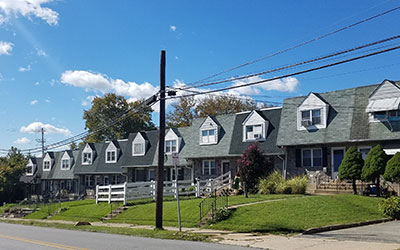Social Equity — Housing

Housing is one of the most important issues for understanding social equity. The location of a person's housing can determine the quality of their school system, hospitals, and nearby employment opportunities. Even today, the discriminatory housing policies of past decades are still having an impact. Also, the lack of affordable housing and rental units can make housing a challenge for individuals from disadvantaged communities. Topics addressed in this section are: Affordable Housing; Tangled Titles; Potential Displacement from Gentrification; and Housing Cost Burden.
View the Planning Commission webpage on housing. A wealth of information on housing in Chester County is also available from the Chester County Department of Community Development. They have established web pages that address General Housing Issues and Fair Housing and Equal Opportunities.
View mapping illustrating social equity and housing in Chester County. This mapping addresses: rental units and rent amounts; housing units with mortgages; housing age; and cost of owner-occupied units.
Affordable Housing for Disadvantaged Communities
One of the best sources for information about housing and social equity is Habitat for Humanity, a decades old non-profit that builds affordable housing. They have developed the five following general policies which are applicable to communities in Chester County, as follows:
- Increase opportunities for homeownership for disadvantaged populations by:
- Increasing access to down payment assistance programs, like matched savings programs and advanceable tax credits for low-income first-time homebuyers.
- Increasing access to affordable credit by extending mortgage and business credit to underserved, low-income and minority homebuyers and communities.
- Investing in affordable homeownership through initiatives like expanding government grants that finance affordable home construction that can help builders create lasting, sustainable homeownership opportunities.
- Retargeting the mortgage interest deduction to make it more accessible to low-income homeowners, including homeowners of color.
- Invest in distressed, racially segregated communities and formerly segregated neighborhoods which sometimes continue to suffer from disinvestment and economic distress.
- Revise outdated policy and zoning choices that led to segregation and the underinvestment in communities of color. Zoning modifications like lowering minimum home- and lot-size requirements, permitting duplexes, and allowing apartments in more locations can help achieve this.
- Invest in affordable rental housing. For example, Charlottesville, Virginia, and other cities have successfully implemented their own housing voucher programs.
- Minimize the damage of COVID-19 on disadvantaged households. Disadvantaged renters and homeowners have become at higher risk of losing their homes, having entered the health and economic crisis with less access to stable and affordable homes.
Some useful websites that address this issue include:
- The Urban Institute: Applying a Racial Equity Lens to Housing Policy Analysis
- The Urban Institute: Fair Housing and Housing Discrimination
- National League of Cities: Embedding Racial Equity in Housing
- Brookings Institute: The Great Real Estate Reset
- HUD Office of Policy Development and Research: Housing Discrimination Against Racial and Ethnic Minorities 2012
Tangled Titles

When a homeowner dies without a will, the ownership of the home is often passed on to the deceased owner's several descendants, who may be their children, grandchildren, or any combination thereof. The term "Tangled Titles" refers to inherited housing units owned by several family members who do not agree as to how to maintain the property, and so the property sits for months or years without repairs before being sold at a reduced cost. In low income and disadvantaged communities, where access to estate lawyers is limited or simply unaffordable, tangled titles are more common. Eliminating tangled titles is therefore a useful tool for ensuring that low-mod income families can retain homeownership over generations.
Some useful websites that address this issue include:
- Pew: How 'Tangled Titles' Affect Philadelphia
- Community Legal Services of Philadelphia: Resolving Tangled Titles in Philadelphia
- Philadelphia Legal Assistance: Tangled Title Frequently Asked Questions
- Philadelphia VIP: Tangled Title Fund
- City of Philadelphia: Tangled Title Information Sheet
Potential Displacement from Gentrification
Discussions of social equity often address the concept that gentrification increases real estate values which displaces low-income residents who can no longer afford to live there. Although such a scenario can happen, displacement can also occur due to many other reasons such as the closure of a major employer. Furthermore, gentrification does not always spur displacement. Nonetheless, planners should always be aware of the potential for gentrification-based displacement and pursue strategies to mitigate it.
Some useful websites that address this issue include:
- Washington Post: Yes, you can gentrify a neighborhood without pushing out poor people
- Bloomberg: The Complicated Link Between Gentrification and Displacement
- Federal Reserve Bank of San Francisco: Gentrification and Displacement
- The City of Portland, Oregon: Gentrification and Displacement Studies
- Metro Politics, City University of New York: When Measurement Matters: Displacement, Gentrification, Residential Mobility
Middle Income Housing or "The Missing Middle"

The term Missing Middle Housing describes housing within walkable areas with more than one unit at compatible scales to existing neighborhoods. The word "Missing" is used since these housing types are often prohibited in certain zoning districts. The word "Middle" is used because the housing exists on a spectrum between single-family detached units and high-rise apartment buildings. Missing Middle Housing types commonly include twins, townhouses, duplexes, triplexes, quadraplexes, multiplexes, and cottage courts. View the Planning Commissions 2022 guidebook on Missing Middle Housing.
Some other useful websites that address this issue include:
- City of Arlington, VA: Missing Middle Housing Study
- American Planning Association: 5 Practical Zoning Hacks for Missing Middle Housing
- The Alliance for Missing Middle Housing: What is Missing Middle Housing
- Montgomery County, MD: Missing Middle Housing in Montgomery County
- City Of Minneapolis, MN: The Missing Middle
Housing Cost Burden
Many households in disadvantaged communities tend to be low to moderate income. Housing studies consistently indicate that low to moderate households should spend no more than 30 to 35 percent of their income on housing including maintenance, taxes, and utilities. Exceeding this threshold is financially unsustainable. In Chester County, experience has shown households that spend more than the 30 percent are housing cost burdened. When pursuing improved housing or economic empowerment in disadvantaged communities, it is therefore essential to understand how income specifically relates to housing opportunities.
Some useful websites that address this issue include:
- The National Low Income Housing Coalition: Out of Reach Pennsylvania
- The Pew Charitable Trust: The State of Housing Affordability in Philadelphia/Who's cost-burdened—and Why
- Seattle, WA: Race and Social Justice Initiative, Housing Affordability

